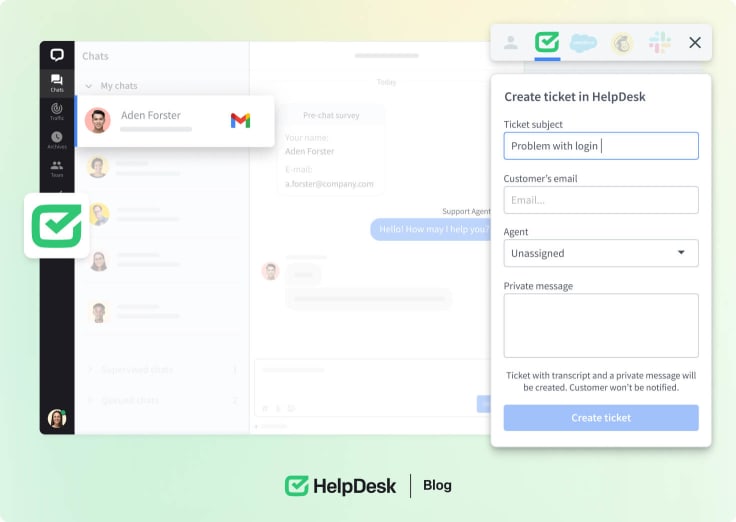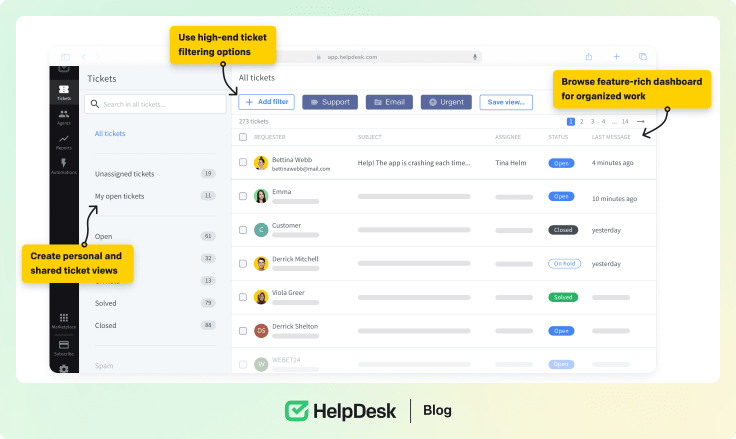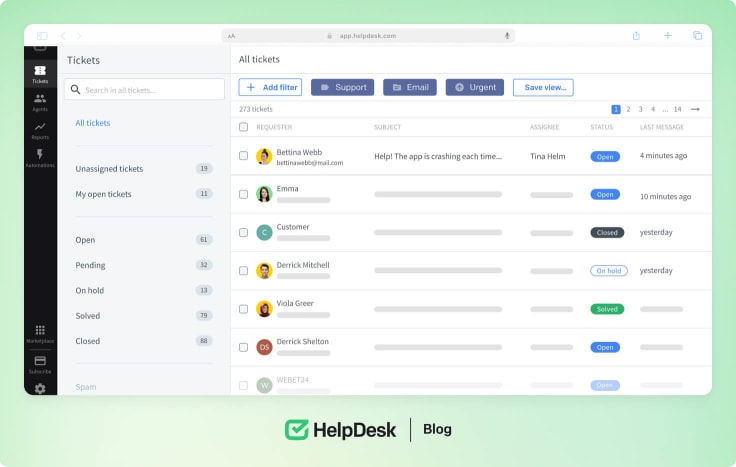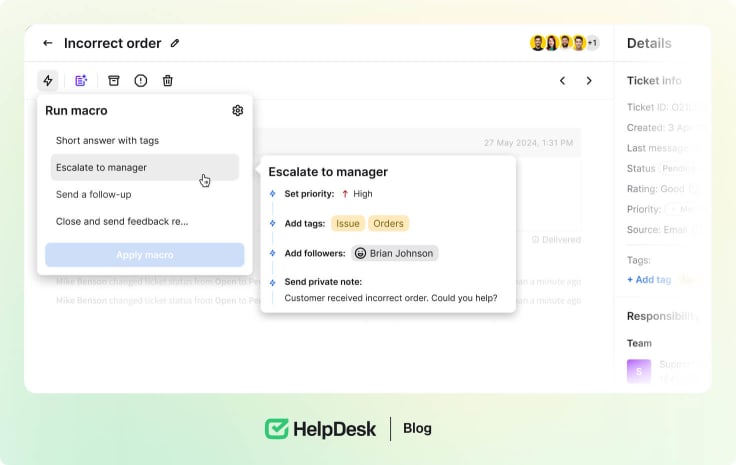Traditionally, customer service in retail was almost entirely a direct human engagement, confined within the four walls of brick-and-mortar stores. It prioritized immediate problem-solving and personal service directly at the point of sale.
However, as customer behavior evolved with technological advances, so did the service delivery methodology. The shift has been towards embracing digital platforms that extend the reach and efficiency of customer interactions beyond physical locations, giving rise to retail IT support, retail help desks, and even retail call centers to assist customers across various channels.
Enter the era of omnichannel customer service—this modern approach integrates traditional in-store experiences with digital touchpoints like websites, mobile apps, social media, and more. The essence of this strategy is to provide good customer service, offering a seamless and consistent experience across all channels. Whether through a retail call center or an online retail support system, businesses can deliver a unified and connected experience.
For example, a customer might explore products on a mobile app, inquire through a live chat, and then complete their purchase in a physical store. This definition of great customer service emphasizes how brands can provide excellent customer service by offering convenience and personalization at every touchpoint. By implementing IT services for retail, companies can ensure that customers have a frictionless experience, no matter the platform they choose to interact with.
An effective omnichannel strategy not only meets customer expectations but also enhances satisfaction and loyalty and ultimately drives sales. As part of retail as a service, offering good customer service can help your business stay competitive in a market that increasingly values convenience and seamless interactions.
Understanding and utilizing these strategies will be vital to your success in the rapidly evolving retail industry, where what is excellent customer service sets brands apart.
Take care of your users at every step of the customer journey. Integrate HelpDesk with LiveChat to provide complex communication. 🚀

What is retail customer service?
Retail customer service refers to the assistance provided to customers before, during, and after a purchase, across multiple channels.
Whether answering pre-purchase queries, assisting during the buying process, or handling post-purchase concerns like returns or feedback, each phase is crucial and demands attentive service to enhance customer satisfaction and loyalty.
The role of direct touchpoints in customer service
Customer support serves as a touchpoint between you and your customers. These direct interactions are fundamental to facilitating transactions and resolving issues arising during the customer journey.
Effective customer service ensures that customers feel valued and supported, significantly influencing their satisfaction and likelihood of returning. This direct engagement helps solve immediate issues and strengthens the relationship between your brand and customers, fostering trust and loyalty.
See how HelpDesk can improve your ecommerce customer support. 🚀
Traditional in-store vs. modern omnichannel customer service
Traditional in-store customer service: Retail customer service was traditionally confined to in-store interactions. This involved face-to-face support, where service quality heavily depended on staff responsiveness and expertise. While personal and direct, such interactions were limited to the store’s operational hours and the physical presence of the customer and the service team.
Modern omnichannel customer service: Modern omnichannel customer service is a new approach that integrates interactions across various platforms, including online, in-store, social media, and mobile apps. With omnichannel service, customers can start an inquiry through one channel and complete it through another without disrupting the service quality or communication. This approach aims to provide a better customer experience by offering multiple support channels to engage with the retailer and making customer service more convenient and flexible.
Integration with HelpDesk
Platforms like HelpDesk are invaluable in supporting these omnichannel efforts. HelpDesk streamlines excellent retail customer service by offering sophisticated features such as ticket management and asynchronous communication.
With ticket management, every customer inquiry or issue is logged and assigned a unique ticket, making it easier for service teams to track and resolve. This system ensures no customer query is overlooked and that each is handled efficiently according to its priority.
Moreover, asynchronous communication allows customers to interact with service agents at their convenience via email, chat, contact forms, or social media, enhancing the transparency and fluidity of communication.
These features improve the efficiency of customer service operations while greatly enhancing the customer experience, making it easier for customers to get the help they need when they need it.
Discover how HelpDesk's solutions can revolutionize your retail customer service 💻, blending traditional values with modern demands to enhance the customer journey. Experience a new level of service excellence.🦸

Benefits of optimized retail customer service
Improving customer service in the retail industry has numerous advantages, including boosting overall business performance and customer satisfaction. A modern ecommerce help desk is critical in realizing these benefits, using technology to manage customer interactions effectively.
I’ll discuss how improving customer service leads to increased loyalty, better brand reputation, higher conversion rates, reduced churn, competitive advantage, and greater operational efficiency.
1. Increased customer loyalty
Effective customer service builds customer loyalty. A customer’s experience with a brand’s service department is often the determining factor in whether they return for future purchases.
HelpDesk facilitates this by ensuring that every interaction, be it a query, complaint, or request for assistance, is handled with care and precision. For instance, its ticket management system ensures no customer issue goes unresolved, which can significantly boost customer satisfaction and encourage repeat business.
The ability to follow up on every issue meticulously sends a message of reliability and commitment to customers, thereby fostering loyalty.

2. Enhanced brand reputation
A brand’s reputation is significantly influenced by the quality of its customer service. Positive customer service experiences can lead to word-of-mouth recommendations and favorable online reviews, which are incredibly valuable in today’s digital age.
HelpDesk supports brands in maintaining a positive reputation through features like feedback collection, which allows businesses to gather and act on customer input.
By continuously adapting services based on customer feedback, you can enhance your public image and attract new customers reassured by positive reviews and ratings.

3. Higher conversion rates
Optimized customer service directly impacts conversion rates by giving potential customers the information and assurance they need to make purchasing decisions.
HelpDesk’s asynchronous communication options allow customers to conveniently inquire about products and services, ensuring they receive timely and relevant information. This responsiveness can help alleviate potential customers’ hesitations about completing a purchase, effectively increasing conversion rates.

4. Reduced churn rate
The churn rate, or the rate at which customers stop doing business with a company, can be reduced through effective customer service. HelpDesk contributes to lowering churn rates by facilitating quick and effective issue resolution.
Its automated routing feature ensures that customer issues are sent to the appropriate department or individual without delay, speeding up the resolution process and minimizing customer frustration. This efficiency helps retain customers who might otherwise seek alternatives due to poor service experiences.

5. Competitive advantage
HelpDesk enhances this competitive edge by providing tools that streamline customer service processes and enhance the customer experience.
For example, the platform’s proactive outreach capabilities allow customer service teams to anticipate and address potential issues before they escalate, demonstrating a level of care and foresight that can set a brand apart.

6. Operational efficiency
Optimized customer service contributes to operational efficiency by reducing redundancies and improving resource allocation. HelpDesk’s features, including effortless automation and AI-driven insights, help streamline customer service tasks.
Automation can handle routine inquiries and processes, freeing human agents to tackle more complex issues. This speeds up service delivery and reduces operational costs by allowing you and your teams to focus on areas that add more value to the customer experience.

You can significantly enhance customer interactions using a comprehensive customer service platform like HelpDesk. The benefits of such improvements include increased customer loyalty, better brand reputation, improved sales and conversions, higher customer retention, better competitive positioning, and enhanced operational effectiveness.
Understanding customer expectations in modern retail
Understanding and meeting customer expectations is paramount for success in a retail environment. Customers are more informed and have higher expectations than ever before. They demand high-quality products and exceptional customer service that is fast, convenient, and consistent across all interaction channels.
1. Speed of service
Modern buyers expect instant solutions, driven by the fast pace of technology and logistics. Speed is everything in customer service — customers want quick replies and problem-solving. Whether they’re contacting you through social media, email, or live chat, they expect a prompt response.
With HelpDesk integrated with the Shopify ecommerce platform, you can elevate your service even further. View buyer details directly in your tickets and track the entire communication as part of the shopping journey, ensuring a seamless experience for your customers.
2. Convenience in customer interactions
Buyers want the shopping process to be as smooth as possible. This includes easy access to support through multiple channels—in-store, online, or mobile platforms. Services like live chat, self-service options, and comprehensive FAQs can enhance convenience by allowing customers to receive help that best suits their lifestyles and preferences.
3. Consistency across channels
Users interact with brands through various touchpoints and expect a uniform experience, whether shopping online, browsing a mobile app, or visiting a brick-and-mortar store. This consistency needs to extend to the customer service experience.
Importance of demographic insights for tailored services
Every customer segment has its unique characteristics and preferences. Age, location, and purchasing power can influence how different groups prefer to interact with a brand. For instance, younger demographics may favor quick digital interactions through social media or mobile apps, while older customers might appreciate more direct contact via phone calls or in-person interactions. Understanding these preferences is essential to delivering good customer service that meets the specific needs of each group.
For example, offering tech-savvy customers advanced digital tools, such as self-service options or chatbots, allows them to manage their transactions efficiently. At the same time, businesses can provide more traditional yet equally efficient retail support options, such as phone-based retail help desks or in-store assistance, for those who are less comfortable with technology. By tailoring customer service to fit these different preferences, companies can ensure a better overall experience and cultivate excellent customer service across all segments.
In addition, collecting and analyzing customer feedback is a crucial strategy for adapting to consumer expectations. Real time feedback mechanisms, such as surveys or online reviews, can offer valuable insights into good customer service and help businesses refine their strategies. These insights can reveal areas where service might fall short and where improvements can be made, contributing to the importance of customer service in retaining loyalty and driving long-term success. Based on these insights, you can enhance customer satisfaction and foster stronger, more loyal customer relationships by personalizing communication and service offerings.
Leveraging technology with HelpDesk
Leveraging cutting-edge technology to enhance customer service is not just an option—it’s a necessity. Platforms like HelpDesk integrate advanced technological tools such as artificial intelligence (AI), machine learning (ML), customer relationship management (CRM systems), and various forms of automation to revolutionize how you interact with your customers.
AI and machine learning
AI and ML are revolutionizing retail customer service by enabling businesses to analyze customer data sophisticated.
For instance, by analyzing past customer behavior, AI can predict future preferences, which could result in proactive service that provides an exceptional customer experience. ML algorithms refine these predictions over time by learning from each interaction, improving the accuracy and relevance of insights provided.
HelpDesk utilizes these technologies to automate responses and streamline the resolution process, boosting efficiency and ensuring consistency in customer interactions.
CRM systems
CRM systems are essential for managing detailed customer interactions and data across various channels.
HelpDesk provides a centralized platform to store all customer information, which is valuable for delivering personalized service. This centralized data repository ensures that no matter which touchpoint a customer chooses to use, the service they receive is informed by their entire history with the brand.
Effortless automation and data analytics
Automation in HelpDesk simplifies many routine tasks that would otherwise consume valuable time and resources.
For instance, ticket routing, follow-up emails, and even some aspects of problem resolution can be automated, ensuring customer requests are handled quickly and efficiently. Additionally, data analytics plays a critical role in evaluating the effectiveness of customer service strategies.
HelpDesk’s analytics capabilities help identify trends and patterns in customer inquiries and feedback, providing actionable insights that can be used to refine customer relations and service practices further.
24/7 support with chatbots, mobile apps, and self-service portals
One of the most significant advantages of HelpDesk is the ability to offer 24/7 customer support. Using chatbots, customers can receive instant responses to common queries anytime, day or night. These chatbots are powered by AI, allowing them to provide scripted responses, context-aware solutions, and information.
HelpDesk exemplifies how integrating advanced technologies like AI, ML, CRM systems, and automation can substantially enhance the efficiency and effectiveness of retail customer service. These technologies streamline operations and elevate the customer experience, ensuring you can meet and exceed their customers’ evolving expectations.
Enhancing understanding through data analytics
Data analytics is another technological tool that significantly impacts retail customer service. For example, analytics can reveal the most common issues faced by customers, allowing you to adjust their service strategies to prevent these issues proactively.
Furthermore, data analytics can help segment customers based on their behavior and preferences, which can be used to tailor marketing and customer service efforts. This targeted approach improves customer satisfaction and increases the efficiency of marketing campaigns and customer service operations.
Training and development in retail customer service
Customer service quality can be a significant differentiator. Ensuring all service staff are well-trained and equipped to handle various customer interactions across all channels is crucial.
Importance of cross-channel training
It’s imperative to train the staff across all customer interaction channels to maintain a consistent level of service quality, no matter how or where customers engage with a retailer.
This requires more than just acquainting the staff with the operational details of each channel, such as in-store, online, over the phone, or through social media. It also ensures they comprehend the significance of upholding a standardized brand voice and service level across all platforms.
Practical cross-channel training empowers employees to deliver a seamless and satisfying customer experience, enhancing brand loyalty and customer satisfaction.
Integrating soft skills and technical knowledge
Integrating soft skills with technical knowledge forms the backbone of excellent customer service training. While technical skills may enable staff to use the latest customer service technologies efficiently, soft skills like communication, empathy, problem-solving, and adaptability enhance the customer interaction experience.
Training programs should include modules on conflict resolution, emotional intelligence, and customer psychology to better equip staff to handle complex and sensitive issues. These skills are particularly vital in scenarios where customers may be frustrated or upset—handling such situations gracefully can turn a potentially negative experience into a positive one, reinforcing customer trust and satisfaction.

Ongoing training programs and feedback mechanisms
The retail industry continually evolves, necessitating ongoing training programs that keep staff updated on the latest tools, techniques, and good customer service examples with best practices. Regular training sessions refresh essential customer service skills and introduce new knowledge and strategies as the market and technologies develop.
Additionally, implementing robust feedback mechanisms is crucial for continuous improvement in customer service. These mechanisms can include customer feedback surveys, peer reviews, and performance analytics. Feedback from these sources should be systematically analyzed and used to inform future training programs.
You can ensure their staff is well-prepared to meet the challenges of modern customer service by investing in comprehensive training and development programs that enhance technical and soft skills. It’s also important to establish a culture of continuous learning and feedback.
Personalization strategies in retail customer service
Personalization has become a cornerstone of modern retail, fundamentally changing how businesses interact with customers. Tailoring experiences and communications to individual preferences and behaviors can significantly enhance customer service and deepen customer engagement.
Enhancing customer service through personalization
Personalized customer service goes beyond using a customer’s name in an email. It involves curating experiences, offers, and interactions based on individual customer data to create a uniquely relevant and engaging journey for each person.
Here are a few ways personalization can transform customer service:
1. Personalized marketing communications: Using customer data to send marketing messages that align with the individual’s shopping habits, preferences, and previous purchases can increase the effectiveness of promotional campaigns.
2. Tailored recommendations: E-commerce platforms can use algorithms to analyze customers’ purchases and browsing behavior and suggest products they’re likely to buy.
3. Customer-specific support solutions: When a customer contacts support, having their history available allows customer service agents to provide more informed and tailored assistance.
Balancing personalization with privacy
While personalization can significantly enhance the customer experience, it requires access to detailed customer data, which raises privacy concerns. You must navigate the fine line between personalization and privacy to ensure customer trust is not compromised.
Here are key strategies to achieve this balance:
-
Transparent data use: Inform customers about what data is being collected and how it will be used. Transparency builds trust, and customers are likelier to share their information if they understand the benefits.
-
Opt-in and opt-out options: Give customers control over their data by allowing them to opt in or out of data collection practices. This complies with privacy regulations and gives loyal customers control over their personal information.
-
Data security measures: It is crucial to implement robust security measures to protect customer data. These include encryption, secure data storage solutions, and regular security audits. Data security protects the business from breaches and reassures customers that their information is safe.
-
Limit data collection: Collect only the necessary data to provide exceptional customer service. Unnecessary data can increase the risk of privacy breaches and customer discomfort.
Keep your customer satisfaction high. Join HelpDesk and enhance your support team performance. ⚡
Summary
This article explores the advantages of optimizing the best retail customer service through advanced technological integration and personalized strategies. By leveraging tools such as AI, machine learning (ML), CRM systems, and automation, platforms like HelpDesk can enhance the efficiency of customer service jobs and provide excellent customer service experiences.
HelpDesk ensures seamless omnichannel experiences, enabling consistent and personalized interactions across all customer touchpoints. By integrating features like effortless automation, data analytics, and 24/7 support through chatbots and mobile apps, businesses can meet the growing demand for fast and reliable service. These tools simplify operational processes and contribute to customer service’s importance by improving satisfaction and loyalty.
With HelpDesk, companies can offer good customer service that aligns with customer expectations, regardless of the channel or method of communication. Whether it’s handling inquiries via a retail call center or providing self-service options through a mobile app, the focus remains on delivering what is excellent customer service. By integrating these advanced technologies into their retail IT support, companies can boost their brand reputation, streamline operations, and foster long-term customer loyalty.
Visit the dedicated retail services page at HelpDesk for ecommerce to learn how to implement these innovative customer service solutions and ensure your business remains at the forefront of customer satisfaction and operational excellence.


